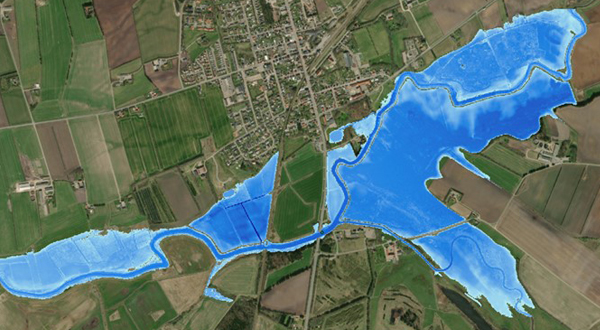
Example of an extended flood map during a major flooding event near Storå
DHI has helped the Danish Environmental Protection Agency (DEPA) conduct initial research on the Storå River to develop the use of artificial intelligence (AI) and the Internet of Things (IoT) to predict water levels and flooding.
The Storå River, spanning 104 kilometres (65 mi), is Denmark’s second largest river and has a history of severe flooding problems in both the town of Holstebro and in surrounding agricultural fields. The Storå River project uses readily available measured data to mitigate flooding issues.
Pilot projects for potential national flooding mitigation
The Storå River project is the third pilot project DHI has worked on with the DEPA to investigate the use of AI and IoT in predicting water levels and flooding. These tests will help the DEPA determine if these methods can be extended to its National Monitoring and Assessment Programme for the Aquatic and Terrestrial Environment (NOVANA).
The first two pilot projects were conducted on Vejle River in 2019 and 2020. The focus of the Vejle River projects was to develop and test AI and machine learning methods using the DEPA’s collected data. The focus of the Storå River pilot project was to further test these methods in other river contexts.
Using IoT and AI for river development
DHI deployed historical river data collected by the DEPA as part of the Internet of things (IoT) and artificial intelligence (AI) for future predictions.
IoT includes any object – or “thing” – that is connected via sensors, software, an internet network and other technologies to transmit and receive data. This connection enables the collection and analysis of these data to make informed decisions. In this case, the DEPA has an extensive network of water level stations around the country monitoring stream water levels and flow.
AI technologies were then used to augment IoT networks with the power of advanced analytics and machine learning. AI enabled DHI to not only manage and process vast amounts of IoT datasets, but to analyse and learn from it. With AI, DHI was able to use the knowledge in the IoT datasets to provide predictions of Storå River conditions in the coming hours and days with respect to water levels and subsequently potential flood risks.
Traditional river flooding mitigation development
Without AI and IoT, flood management and mitigation are traditionally based on static maps that only show potential flood extensions. However, these maps are not interactive and do not account for real-time conditions, which is why these maps cannot be used to guide decision-making during a flood event.
Some cities with high-risk flood areas have developed other types of real-time forecasting systems for water level rises and flooding. Yet, these systems are typically expensive to establish and are only available to key focus areas, not an entire municipality, river or catchment. These systems also do not usually include flood mapping, which can be hard to do in real-time because of the computational time it takes to complete.
About the Storå River
The Storå River originates near Ikast, a small town between Silkeborg and Herning. It flows to the northwest towards Holstebro, the biggest city on the Storå and enters the North Sea through Nissum Fjord.
On the river near Holstebro is the large dam, Vandkraftsøen, which was built in 1941 for a waterpower plant and is now used partially to manage flooding. This dam and the entire lower section of the river are popular for water sports like canoeing and kayaking.
Employing IoT and AI in all Denmark’s rivers
This project demonstrates how DHI can employ AI technologies to provide valuable information to predict and mitigate flooding using historical water level data collected by the DEPA. The idea of this project was to have a second application to assess strengths and weaknesses of an AI method for early flood warning and identify if an AI method can be used to develop such a system for all of Denmark.
For more project-related information contact:
Nicola Balbarini
Water resources engineer, DHI A/S
niba@dhigroup.com
Anders Chr. Erichsen,
Sales manager, DHI A/S
aer@dhigroup.com
Oluf Zeilund Jessen,
Head of water resources department, DHI A/S
ozj@dhigroup.com